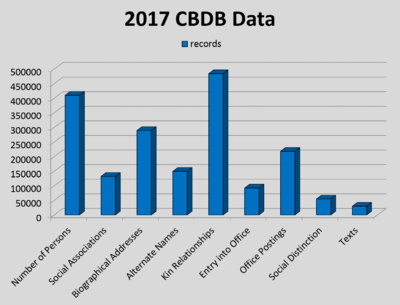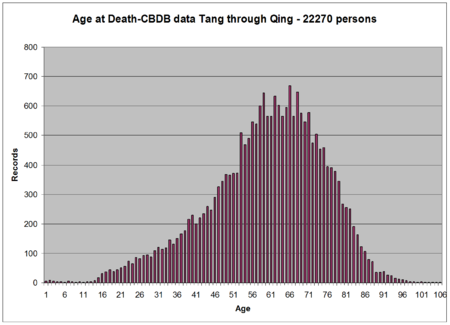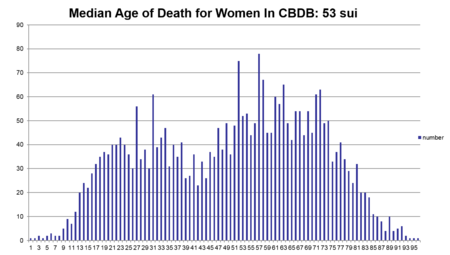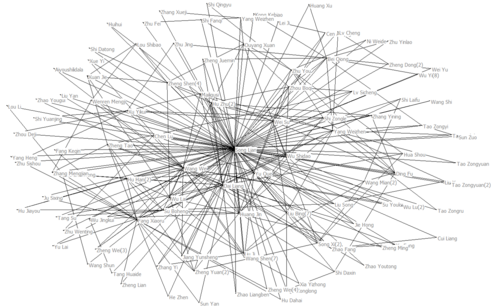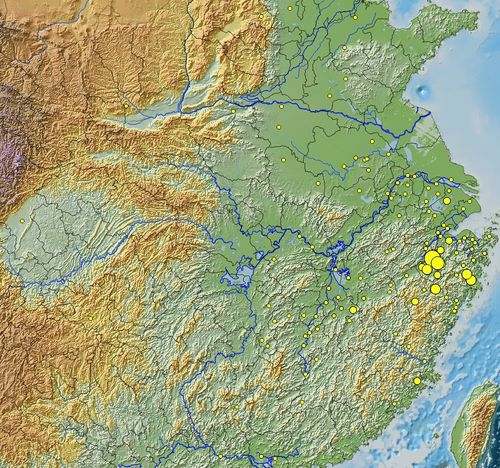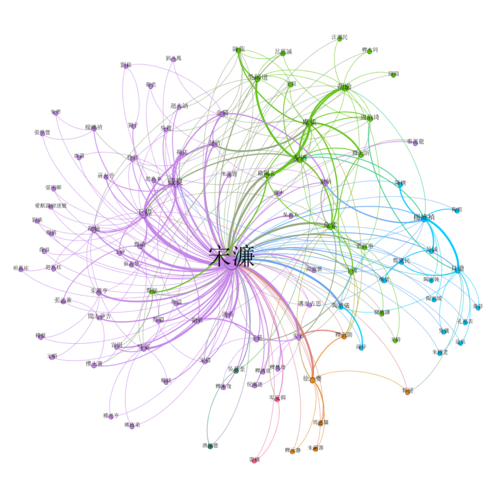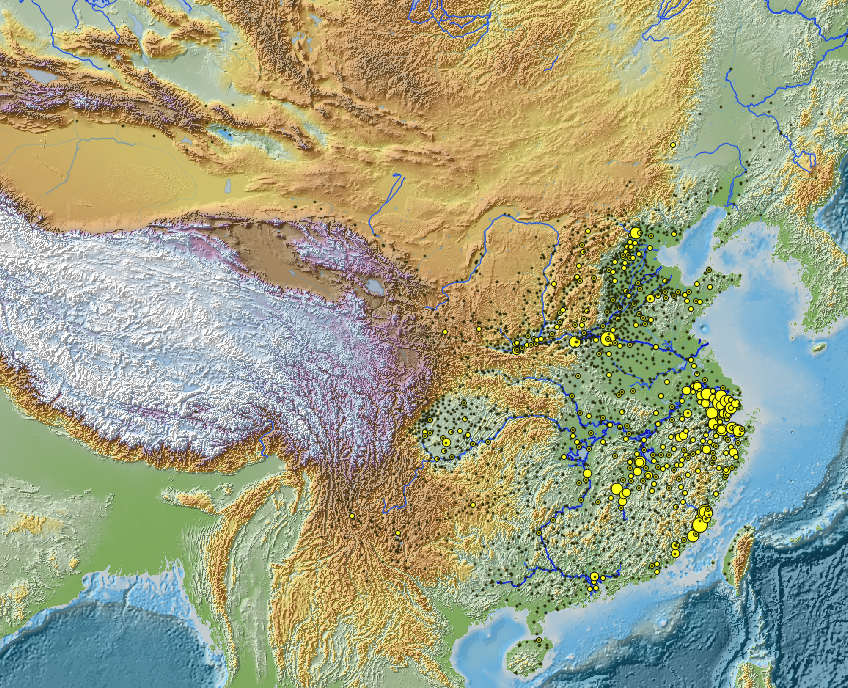“中國歷代人物傳記資料庫”的版本间的差异
Tsui lincoln(讨论 | 贡献) (→Limitations and Strengths) |
Tsui lincoln(讨论 | 贡献) (→History) |
||
| 第3行: | 第3行: | ||
「中國歷代人物傳記資料庫(CBDB)」是關於7世紀到19世紀中國歷史人物的關係型數據庫。截止至2017年8月,CBDB收錄了超過417,000人的傳記信息(包括姓名、生卒年、籍貫、入仕、官職、親屬關係、社會關係等數據)。<ref>{{cite web|url=http://projects.iq.harvard.edu/chinesecbdb |title=China Biographical Database Project (CBDB) |website=Projects.iq.harvard.edu |date=2016-11-07 |accessdate=2016-12-11}}</ref> | 「中國歷代人物傳記資料庫(CBDB)」是關於7世紀到19世紀中國歷史人物的關係型數據庫。截止至2017年8月,CBDB收錄了超過417,000人的傳記信息(包括姓名、生卒年、籍貫、入仕、官職、親屬關係、社會關係等數據)。<ref>{{cite web|url=http://projects.iq.harvard.edu/chinesecbdb |title=China Biographical Database Project (CBDB) |website=Projects.iq.harvard.edu |date=2016-11-07 |accessdate=2016-12-11}}</ref> | ||
| − | == | + | == 項目歷史== |
CBDB 始於社會史專家郝若貝(1932-1996)的工作。<ref>{{cite article|last1=Smith|first1=Paul J.|title="Obituary: Robert M. Hartwell (1932-1996)"|date=1997|publisher=Journal of Song Yuan Studies 27}}</ref>郝若貝首次使用關係型數據庫研究宋代官員的社會和家庭網絡。意識到學界缺乏用於研究中國中古社會史的大型數據集之後,他便踏出了搜集數據的第一步,並通過數據分析,試圖對中國歷史的變遷提出一些有意義的回答。郝若貝透過人名、地名、官僚系統、親屬關係和社會關係等欄目來為數據建立結構。 | CBDB 始於社會史專家郝若貝(1932-1996)的工作。<ref>{{cite article|last1=Smith|first1=Paul J.|title="Obituary: Robert M. Hartwell (1932-1996)"|date=1997|publisher=Journal of Song Yuan Studies 27}}</ref>郝若貝首次使用關係型數據庫研究宋代官員的社會和家庭網絡。意識到學界缺乏用於研究中國中古社會史的大型數據集之後,他便踏出了搜集數據的第一步,並通過數據分析,試圖對中國歷史的變遷提出一些有意義的回答。郝若貝透過人名、地名、官僚系統、親屬關係和社會關係等欄目來為數據建立結構。 | ||
2018年5月11日 (五) 08:11的版本
中國歷代人物傳記資料(或稱數據)庫係線上的關係型資料庫,其遠程目標在於系統性 地收入中國歷史上所有重要的傳記資料,並將其內容毫無限制地、免費地公諸學術之 用。截至 2017 年 8 月為止,本資料庫共收錄約 417,000 人的傳記資料,這些人物主要 出自七世紀至十九世紀,本資料庫現正致力於增錄更多唐代和明清的人物傳記資料。 本資料庫除可作為人物傳記的一種參考資料外,亦冀可敷統計分析與空間分析之用。
「中國歷代人物傳記資料庫(CBDB)」是關於7世紀到19世紀中國歷史人物的關係型數據庫。截止至2017年8月,CBDB收錄了超過417,000人的傳記信息(包括姓名、生卒年、籍貫、入仕、官職、親屬關係、社會關係等數據)。[1]
目录
項目歷史
CBDB 始於社會史專家郝若貝(1932-1996)的工作。[2]郝若貝首次使用關係型數據庫研究宋代官員的社會和家庭網絡。意識到學界缺乏用於研究中國中古社會史的大型數據集之後,他便踏出了搜集數據的第一步,並通過數據分析,試圖對中國歷史的變遷提出一些有意義的回答。郝若貝透過人名、地名、官僚系統、親屬關係和社會關係等欄目來為數據建立結構。 郝若貝教授去世後,將數據和相關程序遺贈予哈佛燕京學社。當時此數據包含超過25,000個歷史人物,4,500 條書目信息,以及他在歷史地理信息系統方面積累的成果。哈佛燕京學社隨後對此數據失去了興趣,所以自 2005 年開始,哈佛大學的包弼德教授開始著手公開發佈郝若貝的成果,並進行擴展。來自加利福尼亞大學爾灣分校的中國文學教授傅君勱參與負責重新設計程序。在北京大學的鄧小南教授帶領下,北京大學中國古代史研究中心的研究生負責修訂和審核數據庫中的數據。中研院歷史語言研究所柳立言教授向CBDB項目提供了數字化的資料。有賴多個數據庫項目的參與和共同努力,CBDB在數據的時代跨度和數據類型上有了巨大的擴展。CBDB 當前由哈佛大學費正清中國研究中心、中央研究院歷史語言研究所和北大中國古代史研究中心共同擁有。更多關於歷史、資助者、貢獻者的信息,請訪問CBDB項目網站。
Sources
CBDB 廣泛使用傳記資料文本來獲取人物信息。這些信息包括學者們整理的傳記索引、正史的傳記部分、祭文和墓誌、地方志、個人文集中的部分資料,以及大量官方記錄。 CBDB 是一個長期開放的項目。它當前已經在以下材料搜集傳記數據:《宋人傳記資料索引》、《元人傳記資料索引》、《明人傳記資料索引》、《清代人物生卒年表》、《宋代郡守年表》、宋(1148、1256兩年)明清三代的進士記錄、明代進士考生的親屬資料等。2018年,項目成員正從唐代主要的史料和索引中搜集人物資料。 CBDB同時也和其他數據庫合作、相互交換數據。CBDB的合作者包括:明清婦女著作項目(Ming Qing Women’s Writings)Ming Qing Women’s Writings、人名權威資料查詢人名權威–人物傳記資料查詢,以及京都大學唐代人物知識庫項(Pers-DB Knowledge Base of Tang Persons)等。[3] CBDB項目當前正系統地從地方志和縉紳錄中搜集職官信息。
Limitations and Strengths
CBDB 使用數據挖掘技術,從大量資料中提取數據。在數據挖掘的工作中,由於 CBDB 會首先挑選行文比較系統、格套化的文本,所以數據挖掘是系統地進行的。這意味著,雖然 CBDB的合作者會透過手動錄入某些歷史人物的詳盡個人信息,但CBDB小組本身不會對單個歷史人物進行深入挖掘。數據挖掘的主要目標是從材料中精確提取數據,並對其進行編碼,而不是核查這些源材料的準確性(那往往是文科研究者的工作)。因此,來自不同材料的錯誤與矛盾的資訊有時會依照原狀被保留在數據中。雖然CBDB 區分主要傳記來源和在其他人傳記中提到的此人信息,但CBDB不會只側重某一材料,而認為其可靠性高於所有其他材料。因此,CBDB很好地保存著時代積累下來的史料,而時代越早,史料自然越少。當前CBDB人物數據主要來自七世紀到二十世紀(從唐代到清代)。這些數據是過去歷史記錄的一個「樣本」(而不是全體)。例如,墓誌是記錄親屬關係的重要資料,但是歷史上只有幾萬方墓誌被保存至今。相似地,只有一部分人的文集流傳至今,而這些將被項目組陸續系統地進行挖掘和處理 。由於傳世資料本身的性質,造成CBDB的數據較多是關於歷史上的官員的,而不是其他人物。[4]
雖然用戶可以用CBDB來檢索單個人物的信息,但是CBDB不僅僅是一部人名詞典。它實際上是一份大型,並不斷增長的人物數據集。這些數據包括人物的名字、職業、入仕方式、親屬關係、社會關係以及著作等。我們可以透過查詢這些數據的查詢來分析時空變遷的宏觀趨勢。當我們分析大批量數據的時候,無論是史料的個別舛誤還是編碼工作造成的微量錯誤,對結論都將不會有太大的影響。關係型數據庫向用戶提供了查詢以及設置查詢變量的強大功能,這是人名詞典所無法提供的。
長遠來看,CBDB將全面挖掘現有的中國歷史資料,並將愈來愈準確地反映中國歷史資料中的傳記數據。
CBDB Contents
The figure on the right shows persons in CBDB distributed across dynastic periods as of 2018/1. The variation across dynastic periods has much to do with the sources used. For example, the high number of persons for the Ming period is the result of mining the nearly complete record of Ming jinshi degree holders, which includes not only the names of M(other), F(ather), FF, and FFF, but also the names of B+ (older brother) and B-.
By rule CBDB assigns a person to a single dynastic period based on their date of death, although much of their career may have taken place during the previous dynasty. The date of death is lacking for a majority of figures. In these cases we rely on the index year. The index year is a heuristic that represents the surmised time a person was in the sixtieth year of life (60 sui in Chinese terms or 59 years old in Western terms) or the year of death if less than 60. The index year is estimated using a variety of rules, based on averages of all CBDB data. For example, on average men pass the jinshi degree in their thirtieth year, a wife is two and a half years younger than her husband, the first surviving son is born in his father's thirtieth year and so on. Thus if one date is certain within a family then index years can be estimated for other family members. Generally this works well, but if it is extended across more than two generations up or down the reliability of the index year decreases greatly. The index year is essential for queries with temporal parameters.
CBDB collects many kinds of data on individuals; the number of data points by category are given in the figure on the left. For each category there is a code table in the database. The main biographical data table assigns each person a unique ID that can be used in various data tables. It codes 235 kinds of Social Associations, which are further categorized by type: the main ones being Writings, Politics and Scholarship. There are 20 Biographical Address codes, including: place of birth, death and burial; basic affiliation (jiguan 籍貫); ancestral address; membership in the Eight Banner system of the Qing dynasty; former address; etc. The seventeen Alternate Name codes include: courtesy name (zi 字), studio names, posthumous name, dharma name, birth order name, childhood names, etc. Every possible kinship relationship in the sources is coded. However, the goal is to reduce these relations to the shortest distance (e.g. F-S(on), H(usband)-W(ife) and rely on computation to generate family trees on demand. Entry into office codes a wide variety of modes of entry, including: many types of examination, recommendation, yin privilege, purchase, etc. Office postings include all office titles and ranks in a dynasty, which in turn can be accessed through a hierarchical tree (allowing one to query all holders of positions within a part of the bureaucratic structure), and places of service for local officials. Social distinction is used in particular to identify the reputation of persons irrespective of office (e.g. poet, artist, monk, merchant). Texts include both the titles of extant and lost works of a person; when possible the bibliographic class is included.
Visualizations
CBDB serves as a data resource for prosopographical research.[5] The data can be queried and then copied into a tool for statistical analysis and visualization. This is illustrated by the two figures contrasting median age of death for all persons in CBDB with the median age of death for CBDB women. The difference, obscured when gender is not differentiated, is due to the higher mortality of women in child-bearing ages. About ten percent of CBDB persons are women.
See also
References
- ↑ China Biographical Database Project (CBDB). Projects.iq.harvard.edu. 2016-11-07 [2016-12-11].
- ↑ Smith, Paul J. "Obituary: Robert M. Hartwell (1932-1996)". Journal of Song Yuan Studies 27. 1997.
- ↑ Reviews of Internet resources for Asian Studies. Resource: China Biographical Database Project (CBDB) [New Release] (Jan 2011, Vol. 18, No. 1, 320). The Asian Studies WWW Monitor.
- ↑ New Approaches in Chinese Digital Humanities - CBDB and Digging into Data Workshop. Peking University. Office of International Relations. 2016-01-11.
- ↑ Gerritsen, Anne. Prosopography and its Potential for Middle Period Research (Workshop on the Prosopography of Middle Period China: Using the China Biographical Database). Journal of Song-Yuan Studies. 2008, 38: 161–201.
Further reading
- Peter K. Bol, Chao-Lin Liu, and Hongsu Wang, Mining and Discovering Biographical Information in Difangzhi with a Language-Model-based Approach[1]
- Peter K. Bol, "The Late Robert M. Hartwell 'Chinese Historical Studies, Ltd.' Software Project," 1999[2]
- Anne Gerritsen, "Using the CBDB for the study of women and gender? Some of the pitfalls" December 2007[3]
- Fuller, Michael A. "The China Biographical Database User's Guide," February 28, 2015[4]
- "Online Guide to Querying and Reporting System," Academia Sinica[5]ZH:中國歷代人物傳記資料庫
外部链接
- 中國歷代人物傳記資料庫
- ↑ Mining and Discovering Biographical Information in Difangzhi with a Language-Model-based Approach (PDF). Arvix.org. [2016-12-11].
- ↑ Peter Bol. The Late Robert M. Hartwell "Chinese Historical Studies, Ltd." Software Project (PDF). Pnclink.org. [2016-12-11].
- ↑ Anne Gerritsen. Using the CBDB for the study of women and gender? Some of the pitfalls (PDF). Humanities.uci.edu. [2016-12-11].
- ↑ Michael A. Fuller. The China Biographical Database : User's Guide (PDF). Projects.iq.harvard.edu. February 28, 2015 [2016-12-11].
- ↑ CBDB Querying and Reporting System - Online Help. Db1.ihp.sinica.edu.tw. [2016-12-11].

